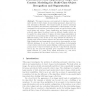1097 search results - page 57 / 220 » Boosting with incomplete information |
130
click to vote
ECCV
2006
Springer
16 years 1 months ago
2006
Springer
Abstract. This paper proposes a new approach to learning a discriminative model of object classes, incorporating appearance, shape and context information efficiently. The learned ...
105
click to vote
AAAI
2011
13 years 12 months ago
2011
Important ecological phenomena are often observed indirectly. Consequently, probabilistic latent variable models provide an important tool, because they can include explicit model...
142
click to vote
ECCV
2004
Springer
16 years 1 months ago
2004
Springer
The problem of tracking a varying number of non-rigid objects has two major difficulties. First, the observation models and target distributions can be highly non-linear and non-Ga...
113
click to vote
SIGMOD
2001
ACM
16 years 10 hour ago
2001
ACM
In this paper, we investigate how to scale hierarchical clustering methods (such as OPTICS) to extremely large databases by utilizing data compression methods (such as BIRCH or ra...
ECAI
2010
Springer
15 years 29 days ago
2010
Springer
We study the problem of fairly dividing a set of goods amongst a group of agents, when those agents have preferences that are ordinal relations over alternative bundles of goods (r...

